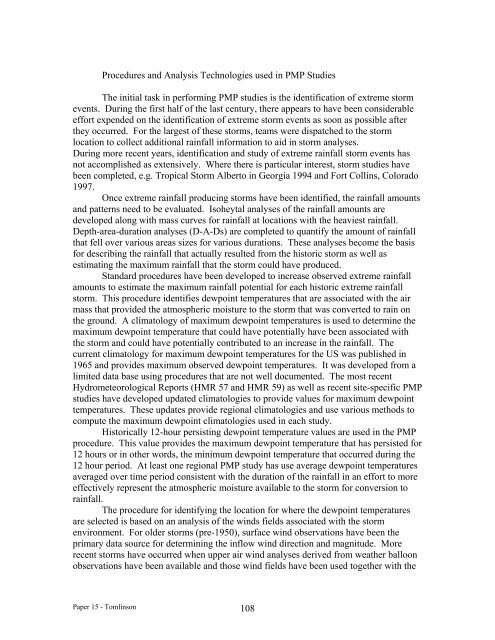Hydrologic Issues for Dams - Association of State Dam Safety Officials
Hydrologic Issues for Dams - Association of State Dam Safety Officials
Hydrologic Issues for Dams - Association of State Dam Safety Officials
You also want an ePaper? Increase the reach of your titles
YUMPU automatically turns print PDFs into web optimized ePapers that Google loves.
Procedures and Analysis Technologies used in PMP StudiesThe initial task in per<strong>for</strong>ming PMP studies is the identification <strong>of</strong> extreme stormevents. During the first half <strong>of</strong> the last centu ry, there appears to have been considerableef<strong>for</strong>t expended on the identification <strong>of</strong> extreme storm events as soon as possible afterthey occurred. For the largest <strong>of</strong> these storms, teams were dispatched to the stormlocation to collect additional rainfall in<strong>for</strong>mation to aid in storm analyses.During more recent years, identification and study <strong>of</strong> extreme rainfall storm events hasnot accomplished as extensively. Where there is particular interest, storm studies havebeen completed, e.g. Tropical Storm Alberto in Georgia 1994 and Fort Collins, Colorado1997.Once extreme rainfall producing storms have been identified, the rainfall amountsand patterns need to be evaluated. Isoheytal analyses <strong>of</strong> the rainfall amounts aredeveloped along with mass curves <strong>for</strong> rainfall at locations with the heaviest rainfall.Depth-area-duration analyses (D-A-Ds) are completed to quantify the amount <strong>of</strong> rainfallthat fell over various areas sizes <strong>for</strong> various durations. These analyses become the basis<strong>for</strong> describing the rainfall that actually resulted from the historic storm as well asestimating the maximum rainfall that the storm could have produced.Standard procedures have been developed to increase observed extreme rainfallamounts to estimate the maximum rainfall potential <strong>for</strong> each historic extreme rainfallstorm. This procedure identifies dewpoint temperatures that are associated with the airmass that provided the atmospheric moisture to the storm that was converted to rain onthe ground. A climatology <strong>of</strong> maximum dewpoint temperatures is used to determine themaximum dewpoint temperature that could have potentially have been associated withthe storm and could have potentially contributed to an increase in the rainfall. Thecurrent climatology <strong>for</strong> maximum dewpoint temperatures <strong>for</strong> the US was published in1965 and provides maximum observed dewpoint temperatures. It was developed from alimited data base using procedures that are not well documented. The most recentHydrometeorological Reports (HMR 57 and HMR 59) as well as recent site-specific PMPstudies have developed updated climatologies to provide values <strong>for</strong> maximum dewpointtemperatures. These updates provide regional climatologies and use various methods tocompute the maximum dewpoint climatologies used in each study.Historically 12-hour persisting dewpoint temperature values are used in the PMPprocedure. This value provides the maximum dewpoint temperature that has persisted <strong>for</strong>12 hours or in other words, the minimum dewpoint temperature that occurred during the12 hour period. At least one regional PMP study has use average dewpoint temperaturesaveraged over time period consistent with the duration <strong>of</strong> the rainfall in an ef<strong>for</strong>t to moreeffectively represent the atmospheric moisture available to the storm <strong>for</strong> conversion torainfall.The procedure <strong>for</strong> identifying the location <strong>for</strong> where the dewpoint temperaturesare selected is based on an analysis <strong>of</strong> the winds fields associated with the stormenvironment. For older storms (pre-1950), surface wind observations have been theprimary data source <strong>for</strong> determining the inflow wind direction and magnitude. Morerecent storms have occurred when upper air wind analyses derived from weather balloonobservations have been available and those wind fields have been used together with thePaper 15 - Tomlinson 108

















